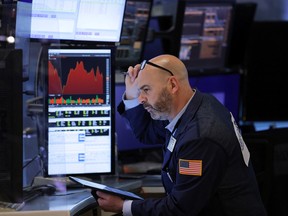Article content
Wall Street ended sharply lower on Wednesday, with Target losing around a quarter of its stock market value and highlighting worries about the U.S. economy after the retailer became the latest victim of surging prices.
Worst one-day loss for the S&P 500 and Dow since June 2020

Wall Street ended sharply lower on Wednesday, with Target losing around a quarter of its stock market value and highlighting worries about the U.S. economy after the retailer became the latest victim of surging prices.
Story continues below
It was the worst one-day loss for the S&P 500 and Dow Jones Industrial Average since June 2020.
Target Corp’s first-quarter profit fell by half and the company warned of a bigger margin hit on rising fuel and freight costs. Its shares fell about 25 per cent, losing about US$25 billion in market capitalization, in their worst session since the Black Monday crash on Oct. 19, 1987.
The retailer’s results come a day after rival Walmart Inc trimmed its profit forecast. The SPDR S&P Retail ETF dropped 8.3 per cent.
“We think the developing impact on retail spending as inflation outpaces wages for even longer than people might have expected is a principal factor in causing the market sell-off today,” said Paul Christopher, head of global market strategy at Wells Fargo Investment Institute. “Retailers are starting to reveal the impact of eroding consumer purchasing power.”
Story continues below
Interest-rate sensitive megacap growth stocks added to recent declines and pulled the S&P 500 and Nasdaq lower. Amazon, Nvidia and Tesla Inc dropped close to seven per cent, while Apple fell 5.6 per cent.
“The cons outweigh the pros for growth stocks at this particular moment, and the market is trying to decide how bad it’s going to get,” said Liz Young, head of investment strategy at SoFi. “The market is fearful of the next six months. We may find out that it doesn’t need to be as fearful as this, and markets do tend to overreact on the downside.”
All of the 11 S&P 500 sector indexes declined, with consumer discretionary and consumer staples leading the way lower, both down more than six per cent.
Rising inflation, the conflict in Ukraine, prolonged supply chain snarls, pandemic-related lockdowns in China and monetary policy tightening by central banks have weighed on financial markets recently, stoking concerns about a global economic slowdown.
Story continues below
Wells Fargo Investment Institute on Wednesday said it expects a mild U.S. recession at the end of 2022 and early 2023.
Federal Reserve Chair Jerome Powell vowed on Tuesday that the U.S central bank will raise rates as high as needed to kill a surge in inflation that he said threatened the foundation of the economy.
Traders are pricing in 50-basis point interest rate hikes by the Fed in June and July.
Unofficially, the S&P 500 declined 4.04 per cent to end the session at 3,923.68 points.
The Nasdaq declined 4.73 per cent to 11,418.15 points, while Dow Jones Industrial Average declined 3.57 per cent to 31,490.07 points.
The S&P 500 is down about 18 per cent so far in 2022 and the Nasdaq has fallen about 27 per cent, hit by tumbling growth stocks. Almost two-thirds of S&P 500 stocks are down 20 per cent or more from their 52-week highs, according to Refinitiv data.
Story continues below




Wall Street’s recent sell-off has left the S&P 500 trading at around 17 times expected earnings, its lowest PE valuation since the 2020 sell-off caused by the coronavirus pandemic, according to Refinitiv data.
The CBOE volatility index, also known as Wall Street’s fear gauge, rose to 31 points after falling for six straight sessions.
Volume on U.S. exchanges was 12.5 billion shares, compared with a 13.4 billion average over the last 20 trading days.
Declining issues outnumbered advancing ones on the NYSE by a 5.09-to-1 ratio; on Nasdaq, a 3.52-to-1 ratio favoured decliners.
The S&P 500 posted one new 52-week high and 37 new lows; the Nasdaq Composite recorded 25 new highs and 242 new lows.
© Thomson Reuters 2022
Story continues below